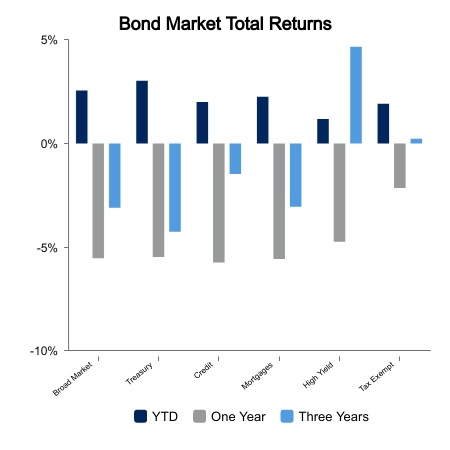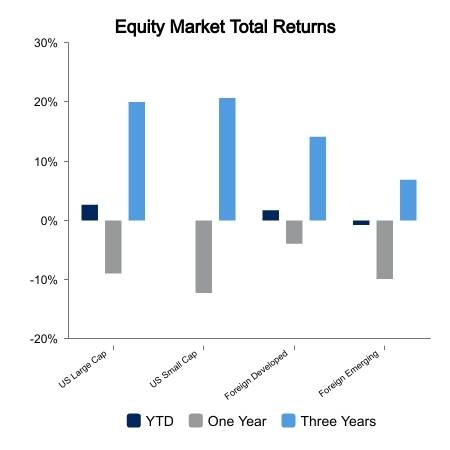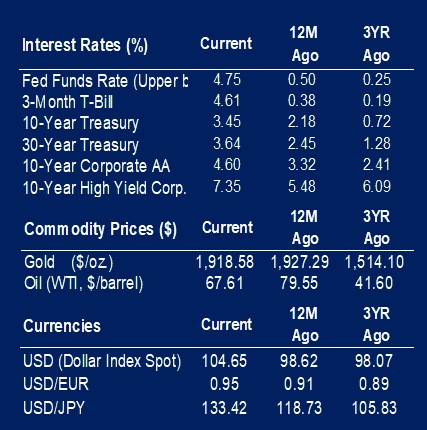Bank Term Lending Program
Investor focus this week has been on actions taken by regulatory authorities to assure safety of deposits at U.S. banks. On Sunday, regulators put into place a new Bank Term Lending Program that provides an additional safety net under all U.S. banks. The new borrowing program increased a bank’s borrowing capacity with the Federal Reserve in case a bank experiences liquidity needs because of depositor withdrawals. Under this program those banks that were closed last week opened again allowing depositors to withdraw funds regardless of amount. A ripple effect regarding the banking system has also been seen overseas as European authorities took actions to pair a stronger balance sheet bank with a weaker one to assure liquidity is in place to address depositor concerns.
Financial Sector Update
Concerns about banks resulted in a predictable reaction with a “flight to quality” into U.S. treasury bonds. Demand drove treasury yields lower and prices higher with the 10-year U.S. Treasury bond falling from a yield of 3.9% to 3.4%. Other parts of the bond market were less impacted, but overall, a broad sector measure of U.S. bond markets was up 2.2% for the week, lifting the year-to-date return to 2.6%. Risk off selling pressure for stocks was concentrated in the financial sector. Stock returns measured by the Russell 3000 Index of U.S. equities fell 1.2% this week, while the financial stocks component of this index saw a drop of 6.6%.
Federal Funds Rate
These market movements have sent the Federal Open Market Committee a signal that their next move of the overnight borrowing rate for banks (Fed Funds) should not be a 25-basis point increase, that just last week seemed to be locked in. Markets now believe the 25-basis point move upward will be delayed to the May meeting.
Bureau of Labor Statistics Figures
This week’s Bureau of Labor Statistics inflation figures reported consumer prices up 6.0% for the headline and 5.5% for core – down from 6.4% and 5.6% in January, respectively. February inflation figures showed a resiliency of core services inflation, driven by housing rents, that supports the idea that the tight labor market is maintaining upward inflationary pressure. Retail sales fell 0.4% in February after climbing in the previous month. Excluding gasoline and autos, retail sales were flat. Eight of 13 retail sectors saw their sales fall last month, led by furniture and department stores.
Employment Figures
Employment figures released showed payrolls grew 311,000 and the labor-force participation rate rose to 62.5%. Also, average hourly earnings climbed 0.2% from a month earlier. There was also an increase of new entrants to the labor force that were unable to find jobs quickly, which resulted in the unemployment rate climbing to 3.6%, vs. 3.4% prior.
 |
 |

Source: BTC Capital Management, Bloomberg LP, FactSet, Refinitiv (an LSEG company).
The information provided has been obtained from sources deemed reliable, but BTC Capital Management and its affiliates cannot guarantee accuracy. Past performance is not a guarantee of future returns. Performance over periods exceeding 12 months has been annualized.
This content is provided for informational purposes only and is not intended as an offer or solicitation with respect to the purchase or sale of any security. Statements in this report are based on the views of BTC Capital Management and on information available at the time this report was prepared. Rates are subject to change based on market and/or other conditions without notice. This commentary contains no investment recommendations and should not be interpreted as investment, tax, legal, and/or financial planning advice. All investments involve risk, including the possible loss of principal. Investments are not FDIC insured and may lose value.

